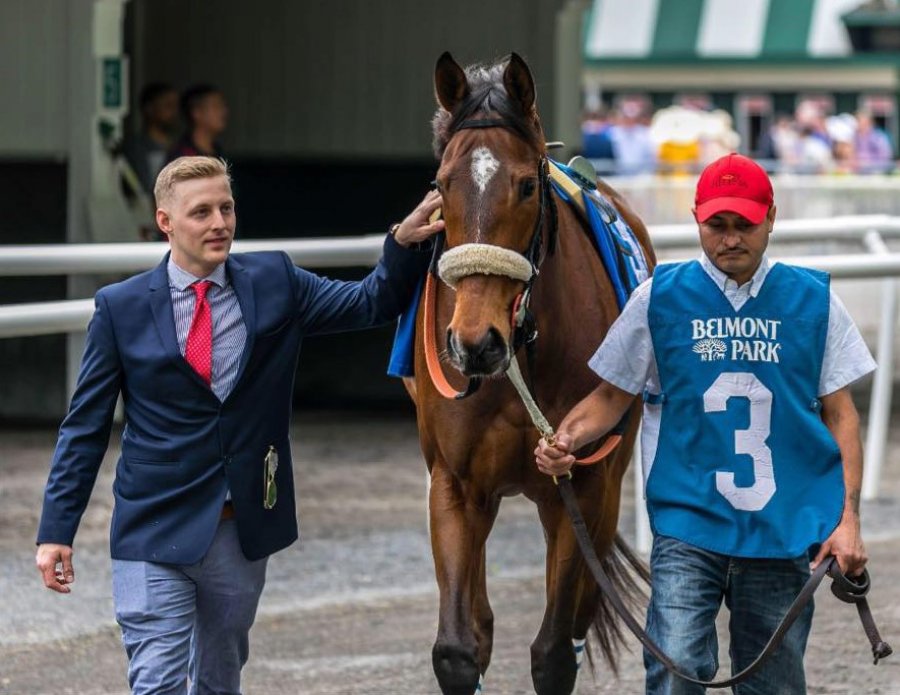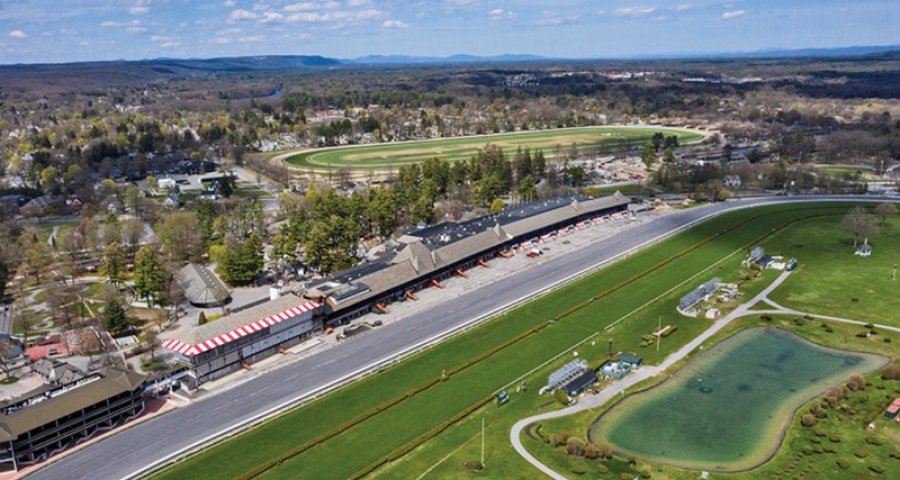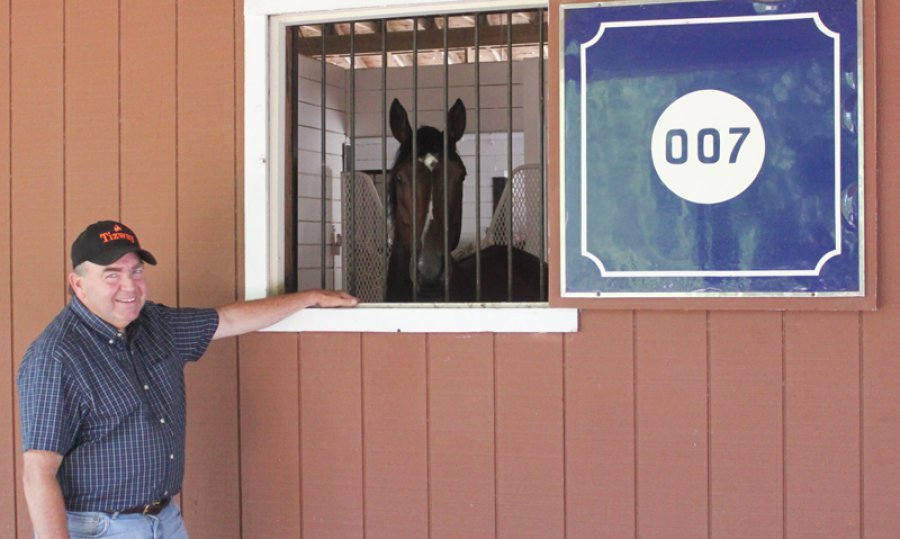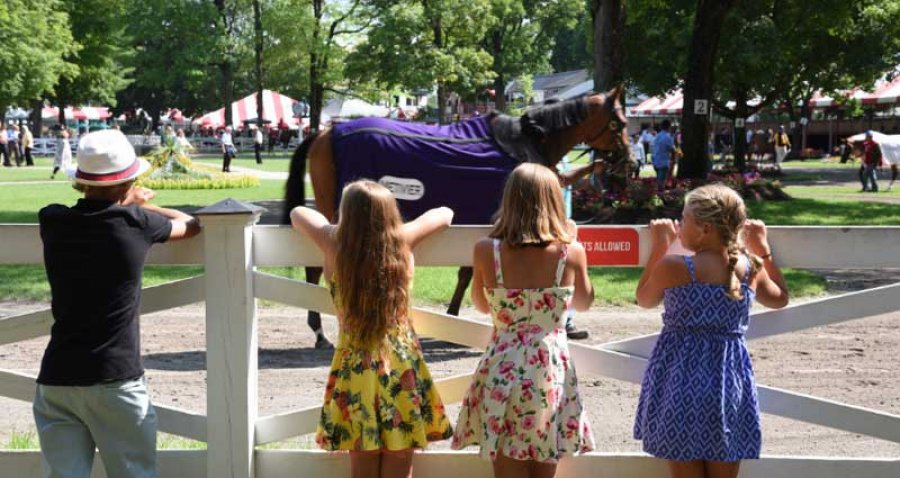Displaying items by tag: Saratoga Race Course
Edmund Davis: Son Learning Through Father’s 3 “Ds”
Just over 10 years ago, Edmund Davis worked at Chipotle during his senior year at Saratoga Springs High School when his father – the well-known retired jockey, Robbie Davis, bought New York-bred Sandyinthesun for $700.
The emerging young adult, who preferred working as an assistant manager while finishing his last year as a high school wrestler, wasn’t that interested in the horse, even though his father encouraged him to come to the barn.
A couple of years later during a Christmas dinner, Edmund asked his father about how much that horse had made. With a chuckle from his sister Jacqueline, his father told him it was over $74,000 through two years of racing.
That’s when Edmund decided to leave the Chipotle kitchen for a career in the horse racing industry. Over the last eight years through the help of his father and others, Edmund has learned about riding horses and becoming a horseman.
Now, Edmund is in his second year of being a trainer with a small, but growing stable of 10 horses, which includes his first Saratoga winner Kinky Sox on July 24.
“It’s an all-around good feeling,” Edmund said. “I took control of the reigns more than last year. It’s all about being logical and how you are training them. It’s going well. I’m getting a little attention. I am really happy about that and the support that I have received.”
One of the things that Robbie has instilled in all six of his children, especially Dylan and Jacqueline who are jockeys at their respective Saratoga and Penn National tracks, as well as Edmund, is the three “Ds:” desire, dedication, and the discipline.
“None of them work without the other,” Robbie said. “If you don’t have the desire, you don’t have the dedication and discipline. I remind them to not get too complacent.”
At 60, Robbie is still resilient as a trainer and exercise rider for trainers that include former Eclipse Apprentice Jockey Champion Wesley Ward, who often got a car ride from Robbie because he was too young to drive when they were riding at Belmont, Aqueduct, and the Meadowlands in 1984.
Robbie believes those three Ds have been an attribute to his remarkable riding career of over 3,300 winners for earnings more than $115.7 million. He also led the jockey colony in stakes wins with six during the 1989 Del Mar meet for Hall of Fame trainers that included Charles Whittingham, Bobby Frankel and Richard Mandella.
At the same time, those three Ds have helped Robbie and his family through challenging moments at both the personal and professional level, even after his retirement and more recently when his wife Marguerite was kicked in the ribs by Dancers for Token, who got skittish from a loose horse on the pony track just before the start of the Belmont meet. A day after that incident, Dancers for Token won his first career race.
“When a horse gets spooked, anything can happen,” Robbie said. “He jumped sideways and caught her on the side and cracked a couple of ribs. She recovered well. She was out for about three weeks, then she came back. She’s still a little tender, but she’s tough. In this business, you have to be Teflon.”
One thing that is tough for Robbie, as well as many horsemen on the backstretch, is the quiet Saratoga Race Course scene in the morning and afternoon as a result of COVID-19 pandemic. For Robbie, this year’s meet feels like an episode from the “Twilight Zone.”
“I feel like I am in the Twilight Zone,” he said. “There is not much traffic. When I get on the track, there is no one around. I ask myself, ‘What’s going on? Can someone wake me up? I’m having a bad dream.’ It’s not Saratoga. It’s hard to get used to. Half of the fun was the crowd and the energy around them. That’s what moves the horses. That’s what moves the riders.”
While the track may not have that energetic atmosphere this season, that has not stopped Robbie and Edmund being motivated for their horses and the sport. The near 29-year-old Edmund has a pulse on all of his horses from riding them in the morning, saddling them in the afternoon, and checking on them in the evening.
“You really have to pay attention,” he said. “I gallop all of my horses. I have a training chart for all of them. I’ll write things down, but when I hit the track, I could change it based on how the horse is feeling that day. I think that is an advantage for me.”
Edmund admitted that he initially lacked confidence around horses and his riding ability until his father provided him knowledge on horses and riding them.
“My dad has taught me so much about horses from looking at the feet to riding them,” Edmund said. “When I started, I wasn’t that confident of an exercise rider. I didn’t feel that I was that good. After watching him ride, I would be in awe. The way he has taught me to ride a horse has been a help to my business.”
Robbie also convinced Edmund to start working with James Jerkens. Through a near three-year internship-like experience from Jerkens, Edmund got to work with stakes winners that included Preservationist, Shaman Ghost and Holy Helena.
“He is a true horseman,” Edmund said about Jerkens. “I wanted to learn and I wanted to be there in the shed row, the paddock, and on the track. It got to the point where I learned a lot and my confidence was up.”
Now that Edmund’s confidence is up, Robbie believes his son, who went from being a lightweight wrestler who competed well in the Section II tournament during his high school career, does have the potential of being a good horseman.
“He’s going to have a future. He’s going to be good,” Robbie said. “It’s fun to see him grow. I’m proud of him.”
A Lookback at Whitney Day
SARATOGA SPRINGS- All eyes were on Saratoga this weekend as Saturday’s 12-race card featured four graded stakes races. Whitney Day did not disappoint this year as along with the great races, Saratoga generated an all source handle record of close to thirty-six million dollars compared to last years Whitney day record of around thirty-two million.
Starting off the highlights for this weekend, in the ninety-third running of the Grade 1 Whitney, Improbable’s victory on Saturday garnered the most attention in the $750,000 stakes race. While looking shaken and unruly at the gate, Improbable’s trainer, Hall of Famer Bob Baffert, was quick to give his praise to the NYRA gate crew in a release to the NYRA.
When asked about this seemingly unexpected choice in praise, Baffert humorously replied “It’s like being in the gate with a bull sometimes…You have to thank the gate crew, the guys they had in there with him. He could have easily turned over, but they did a tremendous job, so I give them a big assist there because they did a great job.”
However, he did not stop there also giving his praise to jockey Irad Ortiz Jr., who managed to snag his second Whitney in three years. In the same release, Baffert commented more on the race saying “As much as he acts up in the gate, he always breaks really well. He breaks like a shot. After that, Irad got him in a nice rhythm. He followed Mr. Buff on the lead and tightened him along there and turned for home. Improbable had been working so well down here at Del Mar. It was a big effort there.”
Improbable’s win matched his namesake as the Whitney was his second time racing outside of California. Going off at 3-1 odds, the horse returned $8.30 on a $2 bet. With this win in the Whintey, Baffert becomes the first trainer since the mid-nineties to win this race back-to-back, the last being Hall of Famer Scotty Schulhofer in 1994-1995. Even with all of the big wins Baffert has had over his career, he still recognizes each new victory saying, “It’s such a prestigious race, and to win it, it means a lot…I’m lucky enough to train for some big outfits, and when you train for them, you get a lot more chances at it.”
While the Whitney did steal most of the spotlight this weekend, the other high grade races did not disappoint either with some upsets and small name victories. In the G1 Personal Ensign, Vexatious managed to pull off a major upset over the reigning champion Midnight Bisou in a last stretch duel. Going off at 5-1, the horse managed to pull off a clutch victory in the seventy-first running of the race.
Trainer Jack Sisterton was elated upon seeing his horse pull off such a win, but was quick to give his thanks to the rest of the team along with him exclaiming, “Words can’t describe the feeling… That’s what we live for, the opportunity to have horses in races like this, let alone win one. It just goes to show how good the people behind me are. I have a great staff and great owners. If it weren’t for the staff or the owners I wouldn’t be in this position.”
In the H. Allen Jenkins Memorial race, Echo town managed to get the first graded score for L and H racing. It was a big win for the small racing partnership. Partial owner Michael Levinson had this to say about the win, “It’s tough to win any race at Saratoga, but to win a prestigious race like the Allen Jerkens is fantastic. I can’t put into words what it means for us…We’re a small group of guys from Oklahoma trying to make a splash and that was a big victory yesterday.
With a weekend of great racing, look forward to this week’s big races such as the GII Saratoga Special, the GI Runhappy Travers, the GI Ballerina Hdcp., the GI Longines Test, the GIII Troy, and the GIII Waya.
Cibelli Continues to Work with Horses from the Gate 34 Years Later
Sometimes, it takes something as simple as watching a horse race on the television for someone to eventually make a career of being in that sport.
That’s what Eddie Cibelli has done.
Over 34 years of working at the racetrack, Cibelli has spent the majority of that time handling thousands of horses as a member of the starting gate crew in New York. However, a popular horse was the starting point to his career.
When he was 15 years old, Cibelli watched the excitement on television when Secretariat cruised by 31 lengths for the Belmont victory and the Triple Crown. At that point, he wanted to work at the racetrack.
“I was mystified by this horse,” Cibelli said. “I saw that race and I saw everyone go crazy. From that moment, I had the bug. I said to myself, ‘This is what I want to get into. I want to do this.’”
Cibelli had been working with Morgan show horses when he lived in Millbrook, just a little over 100 miles south of Saratoga Springs. After graduating from Arlington High School in Poughkeepsie, he lived with a friend attending Hofstra that allowed him to take the bus to Belmont.
Cibelli’s first job was a hotwalker with Gilbert Puentes, who was also in his first year of training, in 1976. From there, Cibelli became a groom Stephen L. DiMauro as he regularly rubbed three horses in which two of them won at Finger Lakes and the other was beaten just a nose at the same track.
Trying to get away from the cold Long Island winter at Belmont and Aqueduct, Cibelli worked for Maryland-based trainer Edmond Gaudet as a groom before becoming a foreman and an assistant.
“I have learned a lot,” Cibelli said. “One thing I have learned is what to do with the horse’s legs – how to feel and look for something. You learn through the years to where your eye is your best friend.”
Cibelli took that knowledge to become a trainer himself in 1984 and started working with thoroughbreds and quarterhorses in Florida and Louisiana. Three years later while galloping in New York, he asked the late assistant starter Fred Lewis about becoming a member of the gate crew.
“I had asked Freddie if there was a shot for me to get on the gate,” Cibelli said. “I wanted to learn that aspect of the game because that was one thing that I hadn’t done. I was good with horses and reading horses. He got me involved and I have been there since.”
The job of being an assistant starter can be challenging, but Cibelli has used his knowledge, experience, instincts, patience and care with any horse going into the gate – whether it is in the morning during training or in the afternoon at the races – for that calming experience.
“I watch their actions to see if they are jumping around. I look at who is lathered up and who is extremely calm,” he said. “With the ones who are moving around a little bit, I pay attention to them a lot more.”
“I do a lot of talking to them,” he added. “I try to keep that calm gentle voice around them so they aren’t headstrong and might hurt themselves. The whole thing is being calm and patient with the horse, and to let them know that everything is OK.”
While Cibelli has been attentive to the horses entering the gate, there have been some tough moments, such as Pomeroy kicking him at the start before winning the King’s Bishop Stakes in 2004.
“One of the toughest parts of this job is when the horse rears up and goes over,” he said “Sometimes, you feel like it’s your fault and how you could have prevented it. These horses are 1,200-1,400 pounds. Once they make a move, it’s already done.”
“I think the biggest aspect is not getting hurt,” he added. “I have been kicked at the back of the gate while putting these horses in there. When I got kicked by Pomeroy, it was a little embarrassing since it happened on TV.”
Still, Cibelli has memorable moments of working with champion horses that include Curlin and Rachel Alexandra, both who he helped school in the gate before they won the Woodward Stakes in 2008 and 2009, respectively. Even then, those moments cannot happen without a solid gate crew.
“I think the biggest aspect is the teamwork you need to have in the gate,” Cibelli said. “Everyone has to know each other and how they can help each other. You need everybody on board. What we do in the morning, we bring it in the afternoon.”
The 62-year-old Cibelli, who lives about 1½ miles away from the Great Sacandaga Lake in Northville from April through November before going to Florida for the winter, started scaling back on his hours last year as he now works in the mornings on the Oklahoma Training Track.
Even though he has worked grueling days starting 6 a.m. to the last race, which could be as late at 7 p.m., Cibelli knows it has been worth it for everyone involved in the horse.
“It has been a long road,” he added. “It is a good feeling to know that you have done your part to make it easier for everyone around you. We have had some really good horse racing over the years and I am glad to be a part of that.”
All-Sources Handle for Opening Weekend at Saratoga Increases by More Than 9% Over 2019
SARATOGA SPRINGS — The New York Racing Association, Inc. announced that all-sources handle for Opening Weekend of the 2020 Saratoga summer meet totaled $80,325,660, a 9.4 percent increase over last year's Opening Weekend.
Under New York State guidelines, Saratoga Race Course is currently operating without spectators in attendance.
In 2018, the opening weekend paid attendance at Saratoga was 109,395. All-sources handle was $71,671,188.
In 2019, paid attendance was 105,690. All-sources handle was $73,441,101.
Saratoga's recently completed Opening Weekend, Thursday, July 16 through Sunday, July 19, corresponds with the four-day period in 2019 from Thursday, July 11 to Sunday, July 14.
Lerman Comes Back to the Spa 35th Season for his Lambholm Horses
Roy Lerman is not one for reflection, but he does have a unique career to reflect upon.
This will be the 35th season at Saratoga as the owner, trainer, and breeder of Lambholm. Initially, Lerman planned to stay at the former Hobeau Farm in Florida for the summer due to the uncertainty around the COVID-19 pandemic.
However, when Belmont Park started racing at the beginning of June and the Florida weather started getting warmer, he decided to bring a small group of horses to New York.
“I had made no plans of coming up here because I didn’t know what was going on,” Lerman said. “I was planning to stay on the farm in Florida for the 2-year-olds still in training. Once [the track] said they were going to run, we decided to come up here. It wasn’t a good alternative to stay in Florida because we are 300 miles from Gulfstream Park. Plus, it’s brutally hot down there.”
Lerman has brought just 12 horses to his well-manicured private stable, which is a few hundred yards from the main track. Besides the improving 3-year-old Joyous Times, he has seven 2-year-olds who are still in training, including East Wing (by Soldat, winner the 2010 With Anticipation Stakes) and Private Code (by Honor Code, winner of the 2015 Whitney Stakes). Although, Lerman indicated those young horses may still need time.
“None of these 2-year-olds are ready to run yet,” he said. “I never push them along, but if they get ready, then they are ready. They have been training and breezing regularly in Florida. Now, it’s time to start increasing their speed.”
Each day since coming to Saratoga in mid-June, Lerman noticed that the area is not quite the same – especially around the track – as everyone is trying to be safe.
“You don’t get a sense of excitement or anticipation here,” he said. “I see a couple of guys who are here. There is no socializing. Saratoga is not the same. People can go to a restaurant, but I haven’t. I don’t want to be paranoid, but I also want to be safe.”
Lerman even had similar experiences when he was racing horses in Florida and more recently at Belmont.
“Nothing is the same,” he said. “When I was racing at Tampa, I knew it wasn’t the same. That’s a nice small facility that can hold 5,000 people, but no one was there. It was like virtual racing. When I was at Belmont a couple of weeks ago, it was bizarre. I came in, checked the horse in the barn, saddled the horse in the paddock, watched the race, got in my car, and drove back.”
Horse racing was not Lerman’s first career. He started as a lawyer for the Department of Labor and a private practice after graduating from Syracuse University and Georgetown Law School. At the same time, he had an interest in horse racing as he slowly made a career of buying a farm to develop and race horses in the mid-Atlantic region.
“It was a long slow process,” he said. “I had farms in Virginia. The principle reason I kept the practice going was for my son. If he ever wanted to become a lawyer, that would make his life easier. I wanted to leave possibilities for him.”
Today, his son Ethan is an assistant judge and has a general practice firm in Missoula, Mont., which also focuses on equine and racing issues. Even Lerman continues to be an occasional consultant on legal matters.
“I still have people who call me about cases in which I can tell them about as a lawyer,” he said. “I will tell them that not every lawyer is the same just like not every doctor is the same. There are different qualities and specialties. It happens all the time. We review the case with them. I am only a consultant in that sense.”
Lerman also indicated there are some similarities in being a lawyer and a trainer, especially since it takes time to develop a case – or a horse.
“The development of a race horse is not too dissimilar of the evolution of a case,” he said. “It takes a long time to get to the end of a civil case and a complex criminal case. You can’t jump over any step in a legal case. It’s the same thing with racehorses. If you skip over a step, you might get away with it, but not often.”
Since saddling his first horse at Shenandoah Downs in West Virginia in February 1978, Lerman has seen his fair share of winners. This includes his first stakes winner with Lava in the 1982 Capital City Handicap at Penn National, back-to-back victories with Dance Mask in his first trip to Saratoga in 1985 and winning the Grade 3 Long Island Handicap in 2016 with Evidently.
Lerman has also bred, raised, and sold many horses, including 1996 Breeders’ Cup Classic winner Alphabet Soup, whose auction bid was never met for $29,000 at the Fasig-Tipton Midlantic 2-year-olds in training sale in May 1993. George B. Ridder eventually purchased Alphabet Soup privately before the late-developing horse won five other graded stakes races in California.
Lerman knew Alphabet Soup had a lot of potential as a 2-year-old, which was confirmed by two of his exercise riders on the farm: Kim Keppick and Olympian medalist Karen O’Connor, the spouse of Olympian gold medalist David O’Connor.
“I knew something about him,” Lerman said. “However, these two riders were excellent. Kim and Karen rode this horse with a couple of other girls in Virginia. They loved this horse. That opened my eyes to the horse.”
Alphabet Soup, who was also a sire at McMahon Thoroughbreds in Saratoga from 2011-2013, has been retired from breeding since 2015 and stands at Old Friends Farm in Kentucky.
As for Lerman, he plans to stay in this business as long as he can. However, one thing Lerman does not regret is his career decision from being a lawyer to owner, trainer and breeder.
“It’s beats spending a career in the labor department as an attorney,” he said.
A Cautious Start
SARATOGA SPRINGS — The bugler blows the Call To The Post. If there are no spectators inside the racecourse to hear it, does it make a sound?
In this unusual summer of a most unusual year, the racing season nonetheless got underway as scheduled on July 16, and is slated to run through Labor Day, Monday, Sept. 7. This year, a lot will be different. Perhaps the biggest is staging the races – or at least the start of the summer meet - without fans in the stands, in compliance with New York State guidelines.
Forty-eight hours prior to the start of the Saratoga meet, NYRA officials and members the city’s Public Safety department staged a joint press conference at the racecourse to discuss additional changes for the start of the summer meet.
“The critical part of this meet is we celebrate racing – but, we celebrate at home. This city cannot have people come to the track and try to watch the races,” said city Public Safety Commissioner Robin Dalton.
The city requested and NYRA complied with the installation of a temporary “privacy fencing” along exterior boundaries of the race course on Union and Nelson Avenues where it is feared fans may congregate on the sidewalk in close quarters to catch glimpses of the action inside.
“The COVID pandemic has really changed the way we do things – both personally and professionally,” said assistant city Police Chief John Catone, who along with Public Safety Commissioner Dalton, was joined by city Fire Department Battalion Chief Aaron Dyer at the press gathering on July 14.
Catone discussed the importance of having a “fluid safety plan” which can flex as COVID-related restrictions are either increased, or loosened – in the latter case enabling the potentiality of limited spectator attendance or horse owners at some point during the summer.
“We were trying to figure every potential scenario: no fans to partial fans to everybody’s going to be back to normal,” said Catone, adding that discussions between city officials and NYRA officials were initiated in April. “The safety and operation plan is very fluid,” Catone said, “and it’s also going to be based on what we see the next week or so, in terms of people who want to show up and try to catch live racing - and we’re going to deal with it accordingly. We want NYRA to have a successful meet but we also do not want to put ourselves in a position like some other states right now – where they opened too early, they didn’t control the pandemic and their numbers have risen dramatically.”
There will still be “a few” officers assigned to the track and its surroundings, including an officer with a bomb-sniffing dog, and others to deal with potential traffic and pedestrian issues.
YOU WANT TO MAKE A BET
In 2019, $2.1 billion was wagered on 2,000 races at Saratoga, Aqueduct and Belmont, according to the New York Racing Association. The Saratoga meet delivered the largest return of gambled money - $147 million wagered at the track, and a $705 million all-source handle – meaning many more dollars were spent on Saratoga races at off-track betting sites across the globe, than were at the actual track. Other 2019 betting dollars: Belmont Spring & Summer – 48 days, $525 million all-source handle; Belmont Fall – 37 days, $275 million; Aqueduct – 25 days Fall, $205 million.
This year, on July 13, NYRA announced that the Belmont Park spring/summer meet generated $15,466,198 in average daily handle from all sources, a 42 percent increase over the daily handle during 2019 spring/summer meet. And despite running 23 fewer days than in 2019, all sources handle during the spring/summer meet totaled $386,654,955.
Financially, the city of Saratoga Springs is estimated to suffer a $14 to $16 million revenue loss this calendar year, or a quarter of the city’s $48.7 million budget due to the onset of the COVID-19 epidemic. The city receives no money from wagering, said Finance Commissioner Michele Madigan. It normally receives funds via an admission tax; those funds go to Saratoga County and are then shared with the city of Saratoga Springs. However, with no fans in the stands as it looks right now, there will be no paid admissions and subsequently no funds to come the city’s way.
NEW RULES FOR JOCKEYS
Two days prior to opening day, NYRA announced a number of updated health and safety protocols that includes closing the track to out-of-town jockeys riding at other racetracks, and requiring all personnel working at Saratoga Race Course in any capacity to produce a negative COVID-19 test in order to access the property. That policy is inclusive of jockeys, valets, NYRA employees, trainers and their staff, outside vendors and credentialed media. A NYRA spokesman Tuesday said that a partnership with Saratoga Hospital was secured for a consistent stream of testing.
The 2020 Saratoga Summer Condition Book currently lists 22 active jockeys and three apprentice riders. This group is to be considered the regular NYRA jockey colony.
Any jockey who rides at a racetrack outside of Saratoga from opening day forward will be considered an out-of-town jockey and will not be permitted at Saratoga Race Course. Out-of-town jockeys not currently riding at another racetrack may be considered for inclusion in the regular NYRA jockey colony provided the jockey does not ride at another racetrack.
In addition to race day safety protocols including standard health screening and temperature check, NYRA says the jockey quarters at Saratoga Race Course have been substantially altered to provide maximum social distancing and reduce density. All areas accessed by jockeys during the regular course of a race day are closed to all outside personnel, including credentialed media, and are cleaned and disinfected throughout the day.
Jockeys and valets are not permitted access to the barn area. In order to work a horse in the morning, the jockey must meet the horse in the paddock and can then proceed to the main track.
Steeplechase jockeys must produce a negative COVID-19 test in order to access the property and will be completely isolated from the regular NYRA jockey colony in a physically separate location. Following that day’s steeplechase race, which will be carded as race one, the steeplechase jockeys will depart the property.
NYRA will follow current Centers for Disease Control (C.D.C.) and New York State Health Department guidance when determining the return of a jockey who has tested positive for COVID-19. This process will include a period of quarantine determined by the severity of the individual case followed by a series of diagnostic tests to rule out ongoing infection.
Following the four-day opening weekend at Saratoga, live racing will be conducted five days a week, Wednesdays through Sundays.
Trying to Rebound from the COVID-19 Pandemic for the Saratoga Meet
LIKE MANY IN THE NEW YORK RACING INDUSTRY, Bond is looking to come back from the pandemic shutdown for his 33rd Saratoga meet from both the racing and breeding areas.
H. James “Jim” Bond is one of the optimistic and well-liked people in New York racing as an owner of a racing stable and farm, a trainer, a breeder and a personality on the backstretch.
That optimism and hard work, which came from his late father through their years of training horses at Finger Lakes during the 1970s and 1980s, has brought him success and winners that include Tizway, Behrens, Will’s Way, Val’s Prince and Buddha. Though, just like with other people in the industry, there have also been challenging times.
However, when the COVID-19 (the coronavirus) pandemic forced New York horse racing to shut down for a little over two months, that may have been the biggest challenge for the 62-year-old Rochester native, especially since it was close to impacting his family’s livelihood.
“I was very nervous,” he said. “It was really hard for myself and my family. During the COVID-19 pandemic, we had earned around $60,000, compared to last year at this time when we earned over $400,000. It was shaky. If we hadn’t started racing by June, I don’t think we would have made it through July and August. We would have had to do some soul searching.”
The situation is looking better for Bond and his team as he continues to prepare and train horses for his 33rd Saratoga Racecourse meet, but it didn’t happen immediately.
Within the first eight days of when Belmont resumed racing June 3, Bond’s horses were struggling to finish in the money. Then after Queenofeverything graduated from the maiden ranks on June 12, several of his horses have followed suit with better races, including recent maiden winners Graetz and Giacosa, as well as a good second-place finish from two-time stakes winner Rinaldi coming off the near 10-month layoff.
The Bond Racing Stable, which includes his wife Tina Bond, is currently fourth in wins with three and ranked among the top 25 owners in earnings (just under $100,000) over 21 racing days of the Belmont Spring Meet that includes the end of the Fourth of July weekend. That’s a respectable accomplishment as they race against hundreds of owners, including leaders Klaravich Stables, Michael Dubb and Juddmonte Farms.
Prior to the COVID-19 pandemic, two people have kept the Bond Racing Stable together at Belmont: Kevin Bond and Ryan Bond, Bond’s older son and younger son, respectively.
However, Ryan was then brought back to the family’s Song Hill Farm in Stillwater to work with the mares to foal on March 1. That left Kevin alone to work with the Belmont stock during that challenging period, which included trying to keep the stable clean and everyone healthy.
“Kevin has done a great job,” the father Bond said. “He has a crew that has been together for a long time. I would send him charts to look over before feed time, then put those charts on the board for training the next day.”
“It has been different,” he added. “We’ve had to have our temperatures checked. Thank God no one got sick around the barn. We run a tight ship. I like cleanliness. We have been a step ahead of everything so far.”
While Kevin Bond had been training horses and managing the barn, Jim Bond knew the restrictions and shutdown around the pandemic were eventually going to impact his son, especially being limited to the living in his downstate home and the barn for the last five months.
“We talked about five times a day,” Jim Bond said. “I heard it in his voice. He would like to come home and have a home-cooked meal. I told him we were going to give him a break before Saratoga.”
While the race horses have been coming together, Bond also has concerns about the impact of COVID-19 on the breeding industry that includes the development of horses and the sales. Since the Saratoga horse sales are canceled this year, many New York breeders are looking to go out-of-state to sell their 2-year-olds and yearlings.
Because of that, there is the possibility that some of those state-breds won’t come back to compete in New York, which means those breeders don’t receive awards from New York Thoroughbred Breeding and Development Fund Corporation.
“There is a 50-50 shot that they may never come back to New York,” Bond said. “If they don’t run in New York, you don’t get any breeders’ awards. That is devastating for us.”
One of the areas that the Breeder’s Awards help recover is the stud fee cost. In past years, Bond has usually spent from $10,000 to $20,000 per stud fee for each of his mares. However, over the last two years, he has paid from $25,000 to $35,000 for each stud fee that includes champions Goldencents, Midnight Lute, and Mineshaft, as well as multiple graded stakes winners Tizway, Sky Mesa, and Munnings.
With just over a dozen 2-year-olds and 11 yearlings, Bond has the flexibility to sell some of them and keep others to develop into racehorses, especially since he had built an indoor arena for winter use rather than having those horses run around on a frozen ground with ice.
“We are very fortunate. I’ve got some great 2-year-olds,” he said. “We decided to keep the yearlings to race next year. We are probably going to invest $15,000-$17,000 more to find out if we have race horses. We have great clientele. Over the past few days, I’ve had investors, who have never bought a horse before, now buying 10 percent and 20 percent shares.”
While these last few weeks before the Saratoga meet have been hopeful for Bond, he is still concerned about the future of his racing stable and his farm, especially if COVID-19 forces another shutdown.
“I have been blessed and fortunate,” Bond said. “However, if COVID-19 comes back in the fall and they shut down racing, then basically we might done. We can only weather so much.”
Horse Racing Resumes This Week - With Changes
SARATOGA SPRINGS — The New York Racing Association opened for training at both the Oklahoma Training Track and Saratoga Race Course this week, coinciding with the return to racing at Belmont Park.
Due to the COVID-19 epidemic, however, both NYRA track locations will undergo big changes. The Belmont Park spring/summer meet will be held without spectators in attendance and much the same is anticipated for the Saratoga meet, which is scheduled to begin on Thursday, July 16 and run through Labor Day, Monday, Sept. 7.
The Oklahoma facility was originally slated to open April 15. NYRA says after consultations with the NYSGC and state and local public health officials, it has implemented a comprehensive set of health and safety protocols designed to protect and mitigate risk for employees, horsemen, backstretch workers and the Saratoga community.
The Oklahoma Training Track and Whitney Viewing Stand will be closed to owners and the public. Access will be restricted to essential personnel duly licensed by NYRA and the New York State Gaming Commission.
All personnel working at the Oklahoma Training Track must test negative for COVID-19 or test positive for the antibodies for COVID-19. This applies to both local personnel as well as those arriving from other regions.
All personnel licensed and approved to be on the property will be required to complete a daily health screening and temperature check conducted by trained EMTs. Face masks or coverings and adherence to strict social distancing measures will be mandatory at all times. Masks and personal protective equipment will be provided.
Saratoga Race Course: To Open, Or Not To Open - Here’s What They’re Saying
SARATOGA SPRINGS — First, the money. In 2019, $2.1 billion was wagered on 2,000 races at Saratoga, Aqueduct and Belmont, according to the New York Racing Association.
The Saratoga meet (40 days) delivered the largest return of gambled money - $147 million wagered at the track, and a $705 million all-source handle – meaning many more dollars were spent on Saratoga races at off-track betting sites across the globe, than were at the actual track. Other 2019 betting dollars: Belmont Spring & Summer – 48 days, $525 million all-source handle; Belmont Fall – 37 days, $275 million; Aqueduct – 25 days Fall, $205 million.
What they are saying about Saratoga:
Gov. Andrew Cuomo: You can’t open an attraction that could bring people from across the state to that attraction and overwhelm a region. We have time to decide first of all, but I don’t think you can open Saratoga Race Course (slated July 16) and the State Fair (Syracuse – slated Aug. 21) unless we can open all large-scale attractions statewide. Density is not our friend...How do you do sit six feet apart at the racetrack?
New York Racing Association plans to open at Belmont first, then Saratoga - Closing to spectators and reducing employees and support staff to only those who are required under the rules of racing.
Assemblywoman Carrie Woerner, 113th Assembly District: move forward planning to hold this year’s race meet. Potential “opportunities including but not limited to social distancing, limited viewership, and personal protective equipment.”
Elsie Stefanik, 21st Congressional District: explore options for the racecourse to reopen for the meet with updated operations based on public health recommendations. Protect public health but also ensure the meet moves forward in a modified capacity to protect the public's health.
Board of Directors of the Adirondack Trust Company: give NYRA time to draw up careful plans—subject to state approval—that would allow a limited number of fans to attend racing consistent with safety protocols. Examples: limiting the number of seats and/or entry tickets sold, marking and monitoring designated viewing areas to ensure proper social distancing, plexiglass screens, mandatory temperature checks and masks, changes in backstretch housing and strong protections for workers, strictly enforced.
Additional Picnic Space at Saratoga Race Course This Summer
SARATOGA SPRINGS — There will be additional green space at Saratoga Race Course this summer with the elimination of a long-standing hospitality tent alongside the paddock.
The 240-square feet of picnic space will be restored prior to the start of the 2020 summer meet, offering fans an unimpeded view of the historic Saratoga paddock, according to a statement issued by the New York Racing Association this week. The Paddock Tent had been a fixture at Saratoga for more than a decade.
"A great deal of what makes Saratoga so special is the ability to see both the horses and jockeys up close. We are removing the Paddock Tent in order to offer more fans the exciting opportunity to watch these incredible athletes as they parade through the paddock prior to each race," NYRA CEO and President Dave O'Rourke said, in a statement.
The Saratoga Springs Preservation Foundation also endorsed the tent's removal. "The landscape of the paddock is a significant historic feature of the Saratoga Race Course. We are very pleased that the large tent is being removed, allowing the green space and important views of the paddock and original saddling shed to be restored," said Samantha Bosshart, executive director of the Saratoga Springs Preservation Foundation, in a statement.
Opening Day at Saratoga is Thursday, July 16 and the meet will run through Labor Day, Monday, Sept. 7. Following Opening Weekend, July 16-19, racing will be conducted five days per week, Wednesdays through Sundays. For more information about Saratoga Race Course, visit NYRA.com/Saratoga.































 How to resolve AdBlock issue?
How to resolve AdBlock issue? 









